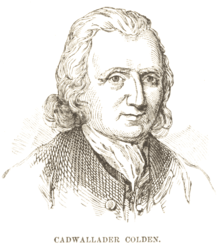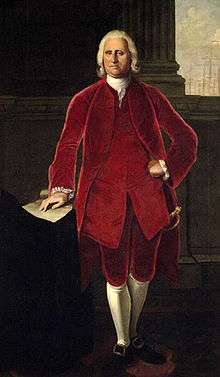Cadwallader Colden
Cadwallader Colden (7 February 1688 – 28 September 1776) was a physician, natural scientist, a lieutenant governor and acting Governor for the Province of New York.
Cadwallader Colden | |
|---|---|
 | |
| 29ºcolonial governors of Province of New York | |
| In office 1760–1762 | |
| Monarch | George III |
| Preceded by | James DeLancey |
| Succeeded by | Robert Monckton |
| 31ºcolonial governors of Province of New York | |
| In office 1763–1765 | |
| Monarch | George III |
| Preceded by | Robert Monckton |
| Succeeded by | Sir Henry Moore, 1st Baronet |
| Personal details | |
| Born | 7 February 1688 Ireland |
| Died | 28 September 1776 (aged 88) near Flushing in Queens County on Long Island in New York. |
| Spouse(s) | Alice Chrystie
( m. after 1715) |
| Relations | Cadwallader D. Colden (grandson) Stephen De Lancey (grandson) |
| Children | 10, including Alexander, Jane |
| Parents | Alexander Colden Janet Hughes |
| Education | Royal High School |
| Alma mater | Edinburgh University |

Early life
Colden was born on 7 February 1688 in Ireland, of Scottish parents, while his mother Janet Hughes was visiting there. His father, Rev. Alexander Colden A.B. of Duns, Berwickshire, sent him to the Royal High School and Edinburgh University to become a minister.
When he graduated in 1705, he continued his studies in medicine, anatomy, physics, chemistry, and botany in London. In 1710, his aunt Elizabeth Hill invited him to Philadelphia where he started his practice in medicine. He briefly returned to Scotland to marry Alice Chryste in 1715, and came back with her to Philadelphia that same year. In 1717, he was invited by Governor Robert Hunter to relocate to New York, and in 1720 he became a surveyor general of New York.[1]
Public life
Colden entered political life in 1720, when Governor William Burnett chose him for provincial council. He served as lieutenant governor and as acting governor in 1760-1761, 1763-1765, 1769-1770, and 1774-1775. He was acting governor of New York from 1760 to 1762 (replaced by Robert Monckton in 1762) and again from 1763 to 1765, and finally from 1769 to 1771 after Henry Moore's death. He was likely one of the oldest acting British governors in New York. He was replaced by John Murray after his last term.
He served as the first colonial representative to the Iroquois Confederacy, an experience that resulted in his writing The History of the Five Indian Nations (1727), the first book on the subject.[2]
On 1 November 1765, Cadwallader Colden was confronted by a huge crowd carrying an effigy of him in a parade to protest the Stamp Act. He seemed to enjoy confrontation and had gone out of his way to defend royal prerogative. Members of the throng had appropriated his coach and added it to the parade; at the end of the route the coach was smashed to kindling and used as part of a great celebratory bonfire on Bowling Green.[3][4]
In 1769, at his request, the New York State Assembly, led by James Delancey, passed a bill providing funds for British troops garrisoned in New York City. The Livingston family voted against as they opposed a standing army in times of peace.
In summer 1775, the British authority in New York came to its end as America entered into Revolutionary era, and Colden retired from public life. On 24 September 1776, the British occupied the city; Colden died four days after that.
Scientist
In 1743, he published a series of essays noting the correlation between filthy living conditions and high rates of disease in New York City.[5] This was particularly prompted by an epidemic of yellow fever at the time. Colden's essays were critical for establishing the sanitation efforts of New York City, and a milestone in the development of the field of public health.[6]
In May 1743, while serving as surveyor general of New York, Cadwallader began a correspondence with Benjamin Franklin encouraging Franklin to create the American Philosophical Society to which he was elected membership one year later.[7] Franklin knew Colden by reputation and was flattered to hear from him.[8] He replied at once, "I cannot be but fond of engaging in a correspondence so advantageous to me as yours must be. I shall always receive your favours as such, and with great pleasure".[9]
Colden refused to be intimidated by the awesome reputation of Isaac Newton, convincing himself that Newton had erred on certain important points. He devoted much of his adult life to correcting the alleged mistakes and in 1751 published in London his views on the subject, Principles of Action in Matter.[10]
Colden wrote a taxonomy of the flora near his Orange County, New York home, which he rendered in Latin and sent to the Swedish patriarch of plant science and Latin nomenclature, Carl Linnaeus, who duly published the work and named the genus in the family Boraginaceae, Coldenia L. Boraginaceae.[11]
Slavery
Cadwallader Colden was a slave owner. In 1721, he ventured to purchase three slaves. He bought two male slaves who were "about eighteen years of age" for manual labor and one female slave who was "about thirteen years old" to assist his wife with raising the children. In 1717, he sold a slave mother to another slave owner in Barbados specifically for the purpose of separating that mother from her enslaved children because if the mother "should stay in this country she would spoil" her children which would negatively impact the children's "value" as slaves to Colden.[12]
Personal life

In November 1715, while visiting Scotland, Colden married Alice Chrystie of Kelso; together they had ten children, including:[13]
- Alexander Colden (1716–1784), who married Elizabeth Nicolls (1720–1774), the daughter of Richard Nicholls (b. 1690).[13]
- David Colden who died as an infant.[13]
- Elizabeth Alice Colden (1721–1785), who married Peter DeLancey (1705–1770), the son of merchant Stephen DeLancey and brother of Gov. James DeLancey.[13]
- Cadwallader Colden, Jr. (1722–1797), who married Elizabeth Ellison (c. 1726-1815), the daughter of Thomas Ellison.[13]
- Jane Colden (1724–1766), who was the first female botanist working in America, and who married Dr. William Farquhar.[14]
- Alice Colden (b. 1726), who married Col. Isaac Willet (b. 1725).[13]
- Sarah Colden (1727–1729), who died young.[13]
- John Colden (1729–1750), who died unmarried.[13]
- Catherine Colden (1731–1762), who died unmarried.[13]
- David Colden (1733–1784), who married Ann Alice Willett (1735–1785).[13]
He died in Spring Hill near Flushing in Queens County on Long Island in New York. He was buried on 28 September 1776 in a private cemetery, in Spring Hill.[13]
Descendants
Through his daughter Elizabeth, he was the grandfather of Stephen De Lancey (1738–1809), a member of the General Assembly of Nova Scotia for the Town of Annapolis, and Susan DeLancey (1754–1837), who was married to Thomas Henry Barclay (1753–1830), a lawyer who became one of the United Empire Loyalists in Nova Scotia and served in the colony's government.[15]
Through his youngest son David, he was the grandfather of Cadwallader David Colden (1769–1834) who served as mayor of New York City in 1818-1821 and a member of the U.S. House of Representatives.[13]
Legacy
Colden is viewed as one of the representatives of the American Enlightenment with recognition of his work in the fields of botany and public health.[16][17]
An elementary school in Flushing, New York was named after him. It is more commonly known as Public School 214 Queens.[18]
Coldenham, a hamlet in Montgomery, New York, is named after him as he was granted 3000 acres of land in the area in 1727.
References
- Schwartz, Seymour I. Cadwallader Colden: A Biography. Amherst, New York: Humanity Books, 2013.
- Colden, Cadwallader, and John G. Shea. The History of the Five Indian Nations Depending on the Province of New-York. New York: T.H. Morrell, 1866.
- F. L. Engelman. Cadwallader Colden and the New York Stamp Act Riots. The William and Mary Quarterly, Vol. 10, No. 4 (Oct., 1953), pp. 560-578.
- The British Lose Control, 1765-1776
- Jarcho, Saul. Cadwallader Colden as a Student of Infectious Disease. Bulletin of the History of Medicine. Volume 29 (1955).
- Duffy, John. The Sanitarians: A History of American Public Health. Urbana: University of Illinois Press, 1990.
- Bell, Whitfield J., and Charles Greifenstein, Jr. Patriot-Improvers: Biographical Sketches of Members of the American Philosophical Society. 3 vols. Philadelphia: American Philosophical Society, 1997, 1:111-119.
- Brands, H W. The First American: The Life and Times of Benjamin Franklin. New York, Doubleday, 2000. ISBN 0-385-49540-4.
- From Benjamin Franklin to Cadwallader Colden, 4 November 1743
- Hindle, Brooke. Cadwallader Colden's Extension of the Newtonian Principles. Williamsburg, 1956.
- Quattrocchi, Umberto. CRC World Dictionary of Medicinal and Poisonous Plants: Common Names, Scientific Names, Eponyms, Synonyms, and Etymology. Boca Raton, Fla: CRC, 2012, p. 580.
- Wallace, Mike (1999). Gotham A History of New York City to 1898. Oxford: Oxford University Press. pp. 127–128. ISBN 0-19-514049-4.
- Purple, Edwin Ruthven (1873). Genealogical notes of the Colden family in America. New York: Priv. print. Retrieved 3 December 2017.
- Gronim, Sara Stidstone (2007). "What Jane Knew: A Woman Botanist in the Eighteenth Century". Journal of Women's History. 19 (3): 33–59. doi:10.1353/jowh.2007.0058.
- Tulloch, Judith (1987). "Barclay, Thomas Henry". In Halpenny, Francess G (ed.). Dictionary of Canadian Biography. VI (1821–1835) (online ed.). University of Toronto Press.
- Gitin, Louis L. Cadwallader Colden: As Scientist and Philosopher. Burlington, Vt, 1935.
- Hoermann, Alfred R. Cadwallader Colden: A Figure of the American Enlightenment. Westport, Conn: Greenwood Press, 2002.
- Public School 214 Queens
Further reading
- The Letters and Papers of Cadwallader Colden (10 vols., 1917-1923, 1931-1935)
- Documents Relative to the Colonial History of the State of New-York (15 vols., 1856-1887). 7. Weed, Parsons & Company. 1856.
- Documentary History of the State of New York (4 vols., 1849-1851)
- Stephens, Henry Morse (1887). . In Stephen, Leslie (ed.). Dictionary of National Biography. 11. London: Smith, Elder & Co.
External links
| Wikimedia Commons has media related to Cadwallader Colden. |
| Wikisource has original works written by or about: Cadwallader Colden |
- Cadwallader Colden at Find a Grave
- Works by Cadwallader Colden at Project Gutenberg
- Works by Cadwallader Colden at Faded Page (Canada)
- Works by or about Cadwallader Colden at Internet Archive
- Fact Monster: Cadwallader Colden
| Government offices | ||
|---|---|---|
| Preceded by James DeLancey (acting) |
Governor of the Province of New York (acting) 1760–1762 |
Succeeded by Robert Monckton |
| Preceded by Robert Monckton |
Governor of the Province of New York (acting) 1763–1765 |
Succeeded by Sir Henry Moore, 1st Baronet |
| Preceded by Sir Henry Moore, 1st Baronet |
Governor of the Province of New York (acting) 1769–1770 |
Succeeded by John Murray, 4th Earl of Dunmore |
| Preceded by William Tryon |
Governor of the Province of New York (acting) 1774–1775 |
Succeeded by William Tryon |